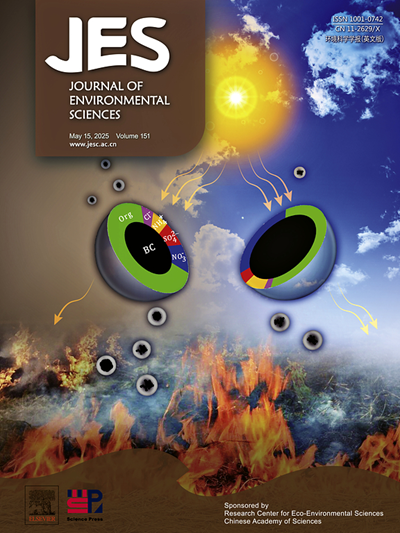Millimeter-scale interactions of nitrogen and potassium on denitrification, anammox, and Feammox in soil fertilization zones
IF 6.3
2区 环境科学与生态学
Q1 ENVIRONMENTAL SCIENCES
引用次数: 0
Abstract
Soil denitrification, anammox, and Feammox are key for nitrogen (N) removal in agriculture. Despite potassium (K) fertilizer enhancing N efficiency, their role in regulation of these processes is unclear. A soil column incubation with 15N isotope tracing was conducted to explore millimeter-scale interactions of N and K on these pathways in soil fertilization zones. After 28 days, individual applications of N and K reduced denitrification-nitrogen removal rate (DNRR), anammox-nitrogen removal rate (ANRR), and feammox-nitrogen removal rate (FNRR) compared to a non-fertilizer control. N fertilizer had a greater effect than K, likely due to the high consumption of dissolved organic carbon by N fertilizer or the increased soil organic matter decomposition by K fertilizer. Combing of N and K increased DNRR, ANRR and FNRR rates by 31 %, 3090 % and 244 % compared to single N, and by and by -53.7 %, 885 % and 222 % compared to single K. These effects diminished with depth and distance from fertilizer sites. The effects of N fertilizer on theses N removal process might be regulate abundance of key microbes (e.g., Limnobacter and Clostridium) and key gene (nirK, hzsB, ACM and Geo) by providing N substrates, while K enhances N metabolism efficiency through enzyme activation, indicated by the downregulation of certain genes (hzsB, ACM and Geo) and a negative correlation with N removal by simultaneously increasing gene expression and enzyme activity. These findings provide insights how N and K together enhance N removal, emphasizing their importance for optimizing this process.

土壤施肥区氮和钾对反硝化、厌氧氨氧化和氨氧化的毫米级相互作用
土壤反硝化、厌氧氨氧化和厌氧氨氧化是农业脱氮的关键。尽管钾肥提高了氮素利用率,但它们在这些过程中的调节作用尚不清楚。采用15N同位素示踪的土壤柱培养方法,探讨了土壤施肥区N和K在这些途径上的毫米尺度相互作用。28 d后,与不施肥对照相比,单施N和K降低了反硝化氮去除率(DNRR)、厌氧氨氮去除率(ANRR)和厌氧氨氮去除率(FNRR)。氮肥的影响大于钾,可能是由于氮肥消耗了大量的溶解有机碳,或者钾肥增加了土壤有机质的分解。与单施氮肥相比,氮肥和钾肥分别提高了31%、3090%和244%的DNRR、ANRR和FNRR率,与单施氮肥相比分别提高了- 53.7%、885%和222%,这些影响随着施肥地点的深度和距离而减弱。氮肥对这些脱氮过程的影响可能是通过提供N底物来调节关键微生物(Limnobacter和Clostridium)和关键基因(nirK、hzsB、ACM和Geo)的丰度,而K通过激活酶来提高氮代谢效率,表现为hzsB、ACM和Geo部分基因的下调,同时增加基因表达和酶活性,与脱氮量呈负相关。这些发现提供了N和K如何共同增强N去除的见解,强调了它们对优化该过程的重要性。
本文章由计算机程序翻译,如有差异,请以英文原文为准。
求助全文
约1分钟内获得全文
求助全文
来源期刊

Journal of Environmental Sciences-china
环境科学-环境科学
CiteScore
13.70
自引率
0.00%
发文量
6354
审稿时长
2.6 months
期刊介绍:
The Journal of Environmental Sciences is an international journal started in 1989. The journal is devoted to publish original, peer-reviewed research papers on main aspects of environmental sciences, such as environmental chemistry, environmental biology, ecology, geosciences and environmental physics. Appropriate subjects include basic and applied research on atmospheric, terrestrial and aquatic environments, pollution control and abatement technology, conservation of natural resources, environmental health and toxicology. Announcements of international environmental science meetings and other recent information are also included.
 求助内容:
求助内容: 应助结果提醒方式:
应助结果提醒方式:


